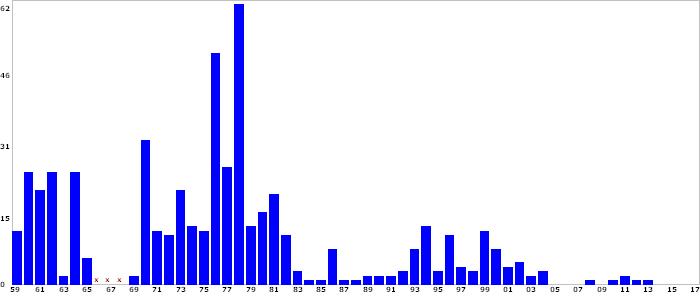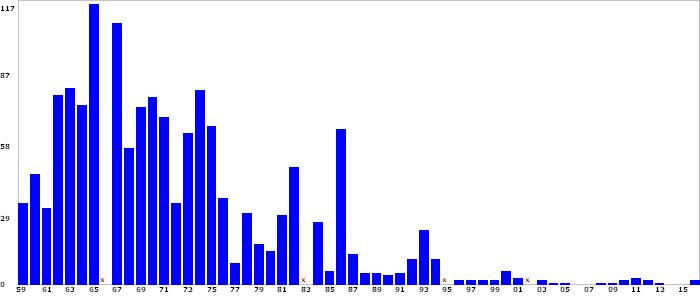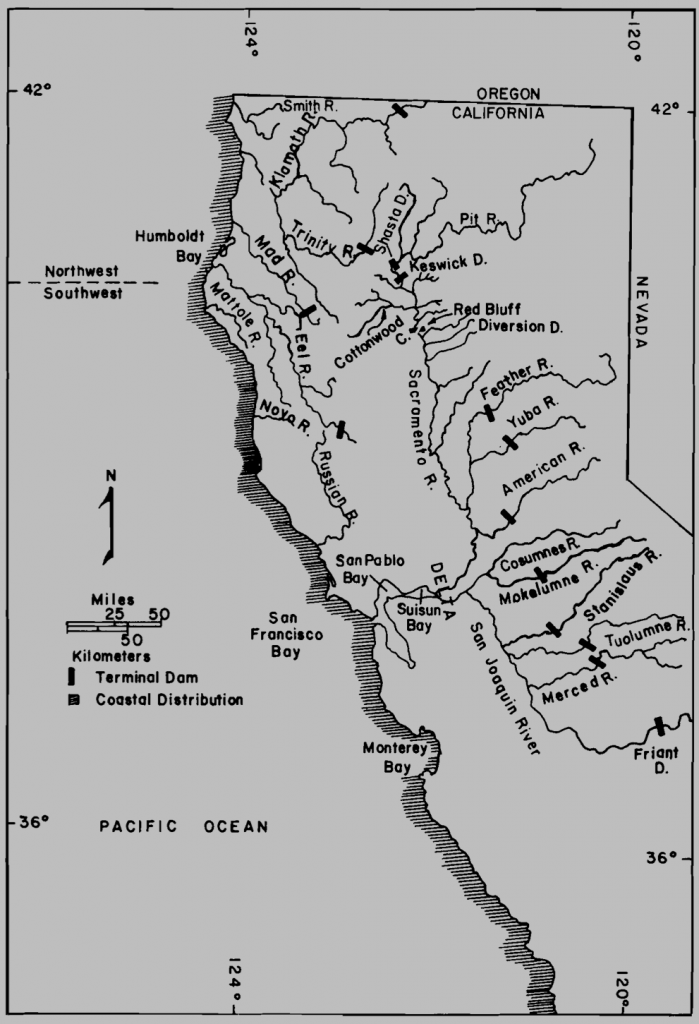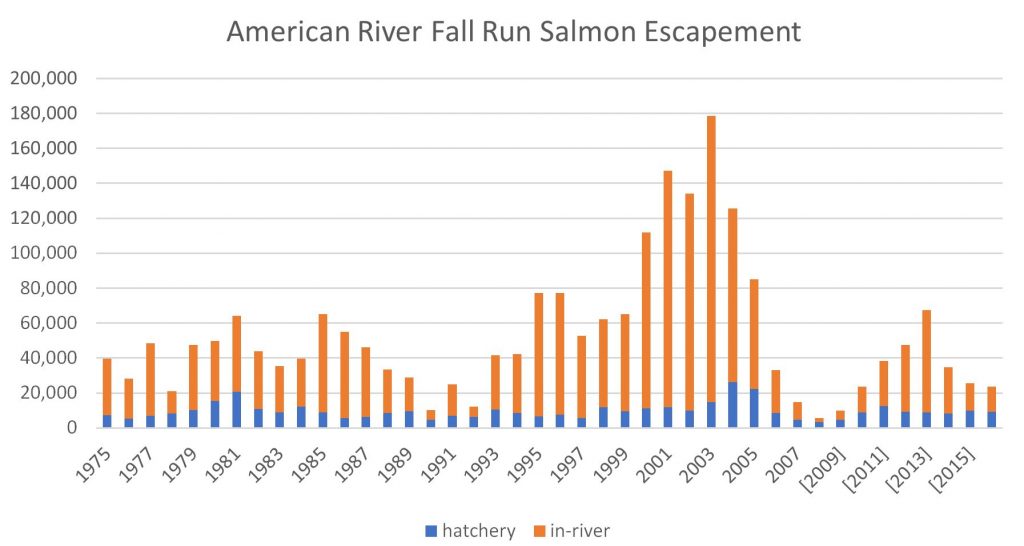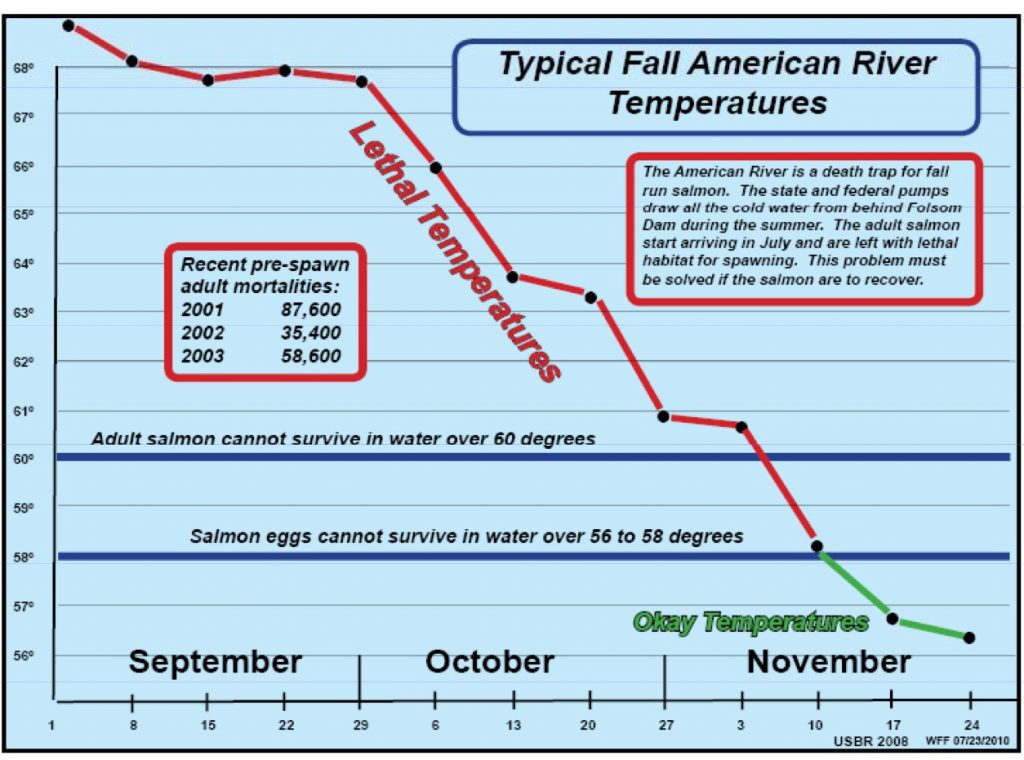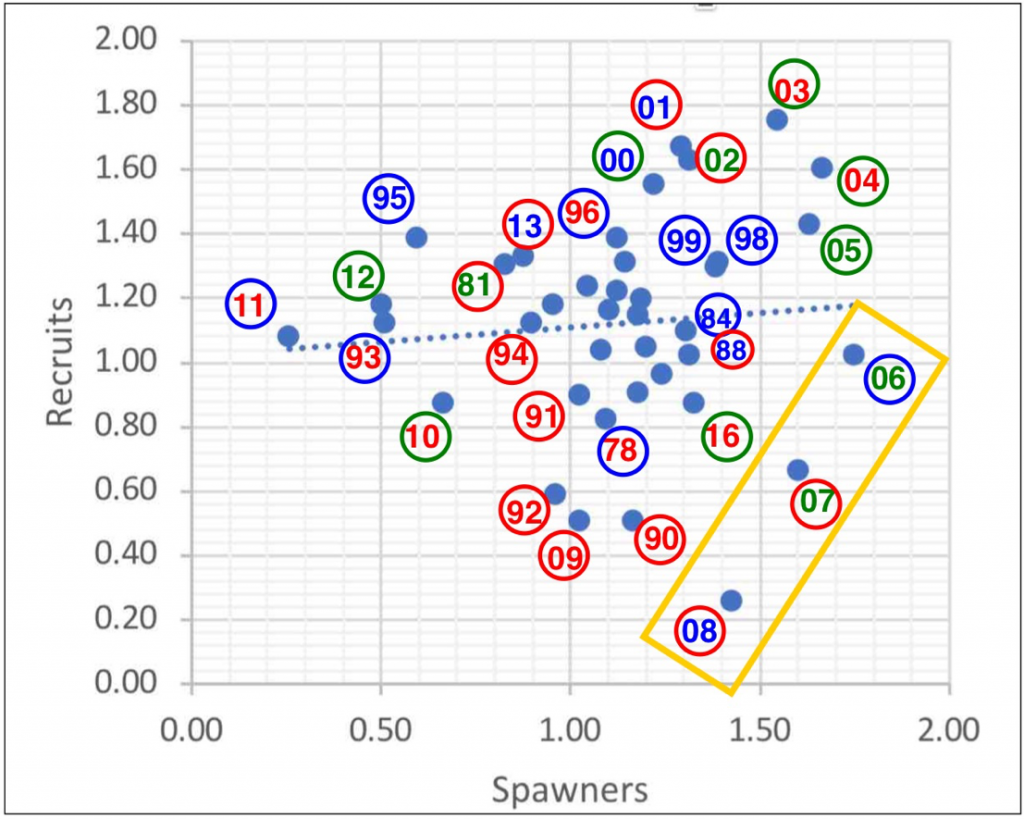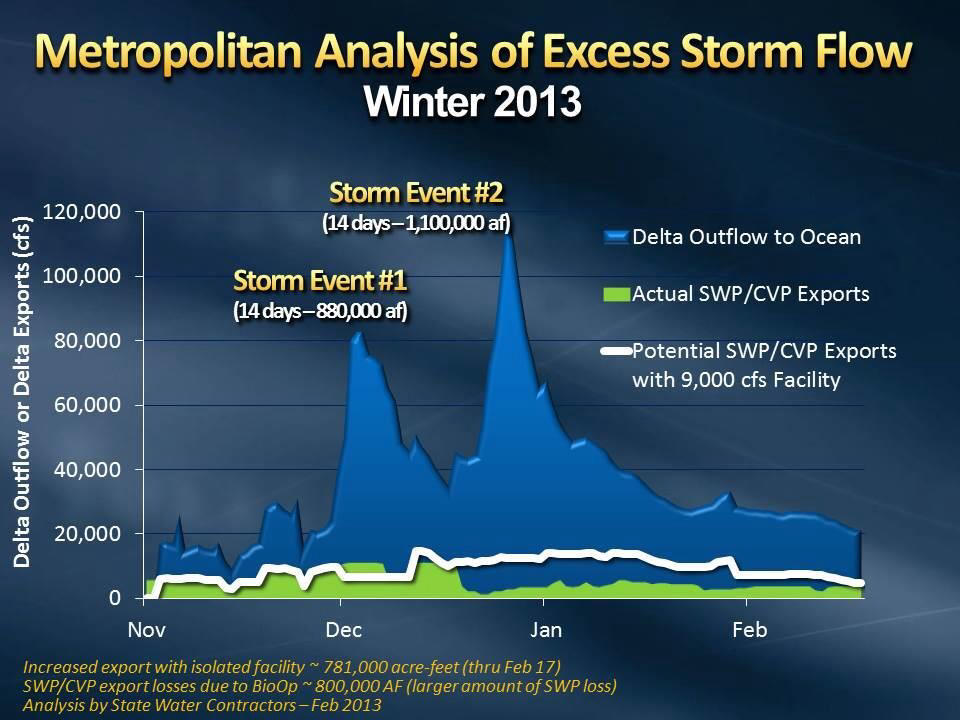The NOAA National Marine Fisheries Service’s biological opinion (NMFS BO) on the proposed “California WaterFix” (Delta Twin-Tunnels Project) concludes there will be no significant effect on protected salmon, steelhead, and sturgeon in the Central Valley. In this post, I address the conclusions in the NMFS BO on the potential effects of WaterFix on the upper Sacramento River salmon, steelhead, and sturgeon in the upper 60 miles of river between Keswick Dam in Redding downstream to Red Bluff.
This is one in a series of posts on the WaterFix. Within that series, it is the first post of the series on the NMFS BO. In this series within a series, I focus on what NMFS determined from its review and the veracity of its conclusions about effects. I pose and respond to the following questions: Will the WaterFix change reservoir storage and release patterns, water temperatures and flow patterns. Will the WaterFix change the rates of survival of Sacramento River salmon, steelhead, and sturgeon? Will changes affect survival and contributions to sport and commercial fisheries?
The Sacramento River between Keswick Dam and Red Bluff is spawning and early juvenile rearing habitat for all four races of salmon, including the listed winter-run and spring-run, and for green sturgeon. All of these species depend on cold-water flows from Shasta reservoir. Winter-run salmon survival was poor in the reach in 2014 and 2015,1 as well as in past droughts when the cold-water supply ran out.
Will conditions improve or get worse with the WaterFix? The NMFS assessment concludes that conditions will worsen with WaterFix only in critically dry years like 2014 and 2015, and possibly in below normal water years. Because such poor survival years are the cause of historic population crashes, it is hard to understand how NMFS concludes that making such years worse is not a worry, or even “jeopardy.”
The NMFS analyses rely on model predictions that NMFS admits are crude, with monthly inputs and outputs. Rules that govern the models are subject to change. In the end, NMFS simply states that adaptive management will protect the salmon in all but critically dry years. The BO makes no attempt to prescribe new rules that would be more protective.
The real concerns about WaterFix are: (1) whether the new Delta export capacity will place new demands on Shasta storage within and among years; (2) whether seasonal flows and water temperatures will change; and (3) whether changes in storage, flows and temperatures will affect salmon, steelhead, and sturgeon.
I really did not get a sense from the BO (or from the EIR/EIS or the Biological Assessment) how WaterFix would be operated. With the extra diversion capacity in the Delta (under the prescribed WaterFix rules for diversions in the Delta), would the Bureau of Reclamation (BOR) or the Department of Water Resources (DWR) release more water from storage in Shasta or Oroville or Folsom to achieve greater south-of-Delta exports under some circumstances? How would they know how much “new” water could be taken, and whether that water would compete with other demands, even from the proposed Sites Reservoir. If they miscalculated the extent of the Shasta cold-water pool in 2014 and 2015, what measures would they take to protect the cold-water pool with the new WaterFix capacity? Would they drain more of Shasta than under present demands? There are lots of questions not posed and not answered.
Excerpts from the NMFS BO, Section 2.5.1.2.
“This preliminary analysis indicated that there is the potential for changes as a result of the PA (WaterFix) in reservoir operations, in stream flows, and water temperatures in the Sacramento River and American River. Therefore, this section assesses potential effects of those changes on listed aquatic species and critical habitat in the American River and Sacramento River upstream of the Delta.” Comment: An example plot from the analyses is shown below. NMFS implies that these are model anomalies and not real. Years 2012 and 2016 were below normal years and represented by the Figure. What did the models assume to create these significant effects? Would WaterFix take more or less water?
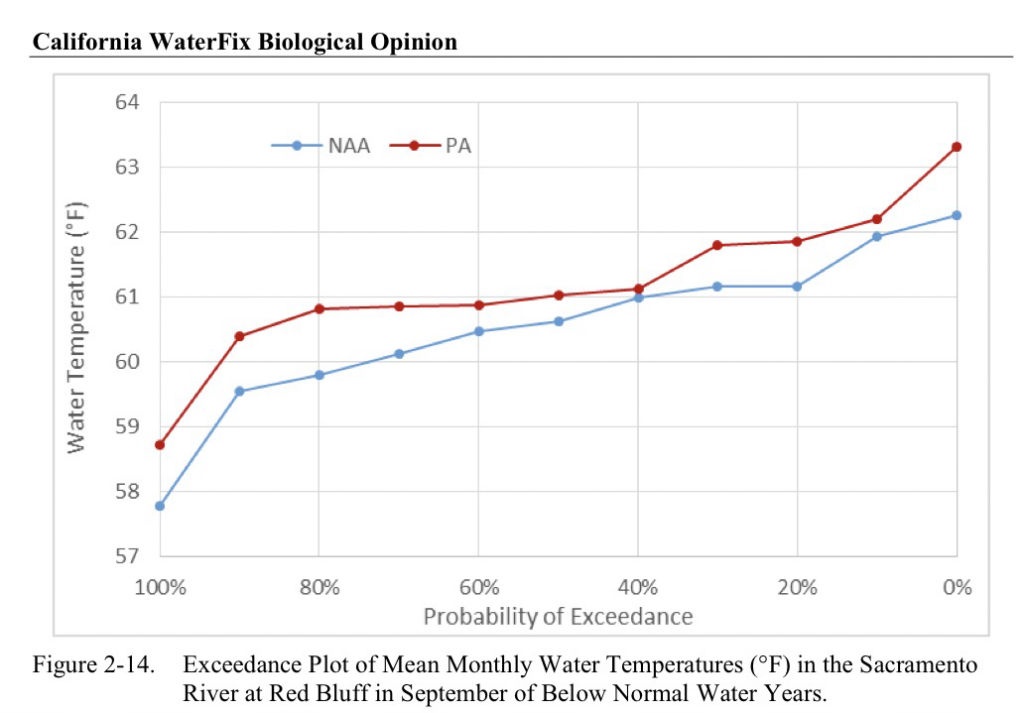
PA is WaterFix; NAA is No Action Alternative.
“Existing Biological Opinions on the Long-Term Operations of the CVP and SWP, NMFS and Reclamation are considering modifications to the RPA relating to Shasta Reservoir operations”. Comment: Like many aspects of WaterFix, other regulatory processes could change the rules. Some changes yet to occur could significantly change the amount of water available for WaterFix.
“Under dual conveyance of the Proposed Action (PA), reservoir water releases and, therefore, CWP [Shasta cold-water-pool] availability may be changed from existing conditions for optimization of exports in the north and south Delta. If CWP storage and management is improved or degraded it could have effects on the viability of listed salmonids.” Comment: Ominous uncertainty for a biological opinion.
“ [T]he extent of habitat cold enough for spawning and early life stage survival changes every year in relation to where in the Sacramento River the upper temperature threshold of 56°F (13.3°C) can be maintained from May to October.” Comment: This is one of the rules that has so easily been changed without adequate review or process. It is one rule that can change to benefit WaterFix water supply.
“Under dual conveyance of the Proposed Action (PA), reservoir water releases and, therefore, CWP availability may be changed from existing conditions for optimization of exports in the north and south Delta. If CWP storage and management is improved or degraded it could have effects on the viability of listed salmonids.” Comment: Incredible uncertainty. There are minimal constraints built into the WaterFix. The conflict between fish and water exports will be more extreme than ever before.
“Recently, a succession of dry years with low precipitation highlighted how difficult the upper river spawning area is to manage for successful spawning and embryo incubation. High mortality (greater than 95%) in the youngest life-stages (eggs, yolk-sac fry) resulted when temperature compliance points were not maintained under 56°F (13.3°C) for the spawning and embryo incubation season (Swart 2016).” Comment: The risks are obvious. Difficulty cannot be an excuse for poor management.
“Green sturgeon have different temperature requirements than salmonids in the upper Sacramento River. The majority of green sturgeon spawn above Red Bluff Diversion Dam. Suitable spawning temperatures must remain below 63°F (17.5°C) to reduce sub-lethal and lethal effects. Temperatures in the range of 57° to 62°F (14 to 17°C) appear to be optimal for embryonic development (Van Eenennaam et al. 2005).” Comment: The assessment on green sturgeon is almost non-existent. The optimal conditions are already exceeded upstream and downstream of Red Bluff in the spring season when sturgeon spawn.
Salmon Conclusions from the NMFS BO
“A high proportion of developing embryos are expected to perish from exposure to lethal water temperatures in critically dry water years.” (p. 279) Comment: This can be reasonably avoided and should not be “expected” or accepted.
“Mean annual temperature-dependent survival would decrease under the PA by 1% in wet years and 3% in below normal years.” (p. 281) Comment: Such predictions from the models are meaningless. Risks to salmon remain serious and are readily avoidable with effective controls.
“All differences in mean annual temperature-dependent survival are likely within the margin of error of the model and are not significant.” (p. 281) Comment: This is true only for the crude model predictions, but not for real risks from WaterFix.
“The SWFSC model results suggest that winter-run Chinook salmon egg survival will largely be the same under the NAA and PA operations.” (p. 282) Comment: Again, this applies to crude model predictions, not to real risks, which are significant given past management, operational rules, and regulatory constraints.
“Overall, the certainty of the three biological tools’ respective ability to accurately estimate thermal impacts to eggs and alevins in the Sacramento River under the PA is low because all three models utilize daily (thresholds analysis and the SWFSC’ egg/alevin mortality model) or weekly (SALMOD) water temperatures downscaled from the same modeled monthly values. Eggs and alevins developing in the Sacramento River spawning gravels experience a thermal regime that varies between day and night and from one day to the next. The downscaled water temperature modeling utilized in all the biological models does not capture that level of thermal variation. Nevertheless, the biological models are useful qualitative indicators of potential thermal impacts under the PA.” (p. 282) Comment: This says it all. The potential risks to salmon and sturgeon from WaterFix are real, unlike the model predictions.
“Adverse thermal effects on these life stages resulting from changes to upstream operations as a result of the PA are not expected. However, for purposes of the analysis in Section 2.7 Integration and Synthesis, the combined effect of PA implementation when added to the environmental baseline and modeled climate change impacts is expected to result in substantial water temperature-related mortality in critically dry years.” (p. 282) Comment: Again, the worst problems for salmon and sturgeon for decades have been in the critical dry years in drought sequences. WaterFix will do little to alleviate the problem, and will likely make it worse.
“There are extensive real-time operations management processes currently in place for CVP/SWP operations that affect water temperatures upstream of the Delta (see BA Section 3.1.5.1 Ongoing Processes to support Real-Time Decision Making), those processes have minimized such impacts in the past (Swart 2016), and the PA does not propose changing the existing real-time operational processes. Therefore, NMFS concludes that the real-time operations management process would minimize adverse effects indicated in the modeling for the PA to a similar extent as the real-time operations process has minimized such impacts in the past.” (p. 282) Comment: Incredible statement. Past poor real-time management has led to the near extinction of winter-run. Even the extremes of 2014 and 2015 were avoidable if management had been effective. Yet WaterFix proposes no changes in management.
“NMFS expects that climate conditions will follow a trajectory of higher temperatures beyond 2030. Not only are annual air temperatures expected to continue to increase throughout the 21st century, but the rate of increase is projected to increase with time. That is, in the early part of the 21st century, the amount of warming in the Sacramento region is projected to be less than it is in the latter part of the century under both low and high carbon emissions scenarios (Cayan et al. 2009). Because water temperatures are influenced by air temperatures, NMFS expects that climate change will amplify adverse thermal effects of the proposed action combined with the environmental baseline and modeled climate change past 2030.” (p. 283) Comment: With future climate change, operations under WaterFix will likely create significant added risks to salmon, steelhead, and sturgeon.
Some Final Thoughts
While it is possible that the WaterFix would cause few changes in reservoir management upstream of the Delta, WaterFix is likely to increase demands at times on that storage, with many potential ramifications. The NMFS BO does not address any such changes and the rules that might limit them. Rules could even become more stringent to protect salmon and sturgeon, thus potentially reducing the water supply benefits of the WaterFix. But without operational constraints for reservoirs and other aspects of WaterFix, there is no basis for NMFS to state in a BO that it has predicted and mitigated the effects of the WaterFix on salmon, steelhead and sturgeon.
Finally, I have seen no suggestions to use WaterFix to improve upon existing Central Valley water operations to benefit salmon. For instance, WaterFix should make it possible to adjust some water demands to allow better management of Shasta’s cold-water pool. For now, WaterFix would seem to be just another tool to exploit the water resources of the Sacramento River system at the expense of salmon, steelhead, and sturgeon.

